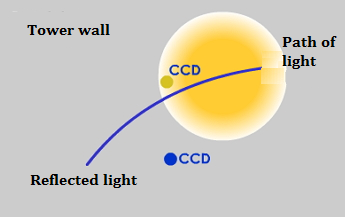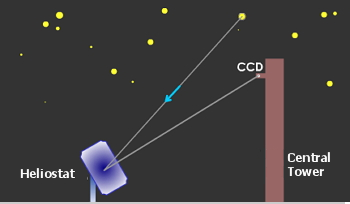NOVEL PROCEDURE FOR THE OPTICAL CHARACTERIZATION OF SOLAR CONCENTRATORS BY RECORDING THE REFLECTED LIGHT OF A STAR
|
Description |
A novel procedure, which allows the optical characterization of solar concentrators by recording the light of a star at night, has been developed. As compared with other known methods, the present one shows the following advantages:
- Very low cost.
- Full optical characterization.
- Measurements are carried out at night and they may be taken in an automatic way and
- The characterization of the mirror is done at working position.
This technology is protected since 2005 by a patent (ES2199081). Partners interested in the implementation of this technology are required.
|
How does it work |
An observer located at the concentration region of a mirror and looking at the mirror sees some regions of if it illuminated because of the reflection of the light source. In fact, light is only observed from those points of the mirror for which the reflection law is fulfilled.

The yellow region represents the light reflected by the star on the wall (or hole) of the central tower. The CCD is located within this region and directed to the heliostat.
The present method relies on the application of these facts to the optical characterization of the mirror, i.e, the determination of the geometrical properties of the mirror allows predicting the features of the image produced by the mirror in any position and for any object. The method lies on recording with a CCD camera provided with the appropriate lens, mirror images when the mirror is in a position for which the light of a star is concentrated in the camera entrance. Applying the reflection law, for each recorded image the components of the unit vector normal to the surface mirror can be calculated for all bright points. By recording images for enough camera positions it is possible to obtain the normal vector map of the whole mirror surface. From now on this method will be named with the acronym SCCAN (Solar Concentrator Characterization At Night).
The SCCAN method provides information on the true direction of the mirror and thus, on the offset errors. For the case of mirrors consisting of facets, data allows checking of facets alignment (canting). In addition this method allows to measure the light intensity distribution in the concentration region for a point source as well as the contribution due to individual regions of the mirrored surface.
This procedure is applicable to any mirror as far as both the focal length and the mirror size have to be much greater than the diaphragm of the camera lens and the mirror has to be steerable under a control system which records the angle coordinates during data taking.
The equipment needed for this technique is only one (o several) CCD cameras and one (o several) PCs and therefore the cost is very low. In addition, characterizing several heliostats is also possible either, by using several cameras, which aim at the different heliostats, or by one larger resolution camera with the appropriate lens. The SCCAN technique has not been tested yet in spherical concentrators with smaller focal length. For its application these solar dishes it will be necessary to solve some technical problems regarding the installation of the CCD camera/s. On the other hand, in principle, the method could be applied in parabolic through collectors if some technical problems are solved and specific analysis algorithms for this geometry is developed.
|
Advantages |

SCAN (Solar Concentrator Characterization at Night) method..
The SCCAN technique may be very useful for the quality control of solar concentrators already installed and working in a solar power plant.
- The characterization is carried out at the working position of the solar concentrator allowing more realistic results as compared with those methods in which the mirror has to stay at the workshop or at a special position.
- Since any star of medium intensity can be used as light source, the mirror can be characterized at any direction of interest independently of the Sun position in the working season. This is an advantage of SCCAN as compared with the techniques which only use the Sun as light source.
- The characterization is carried out at night. Therefore it does not interfere with daytime activities of the solar plant (energy production or tests). In addition the measurements can be carried out in an automatic way without the need of a night operator. Presently a procedure for heliostats is being developed in which tests are programmed during the day and measurements are taken automatically during the night.
- SCCAN allows a full characterization of the mirror. It can detect errors in the slope of the surface of about 1 mrad for any region of the mirror.
- The cost of the equipment is much smaller than that of other similar technique. In particular, for the automatic characterization of heliostats in a central system the cost of the equipment consisting of 2 CCD cameras and 2 PCs for control and analysis is lower than 6000 euros.
|
Where has it been developed |
The research team is being working in the field of cosmic ray physics and gamma rays astronomy since many years ago using ground detectors. This technology has been developed by UCM team in the frame of GRAAL project which in collaboration with Max-Planck institute has carried an experiment of atmosphere Cherenkov radiation using the heliostats of CESA-I field at the Almería Solar Platform.
|
And also |
Funds are sought to continue the development of this technology. The forseen tasks are finish the development of an automatic system to heliostats in a central plant and study the viability of the method in other types of solar concentrators. This technology is protected since 2005 through a patent (ES2199081).
|
Contact |
|
© Office for the Transfer of Research Results – UCM |
|
PDF Downloads |
|
Classification |
|
Responsible Researcher |
Fernando Arqueros: arqueros@gae.ucm.es
Department: Atomic, Molecular and Nuclear Physics
Faculty: Physical Sciences


